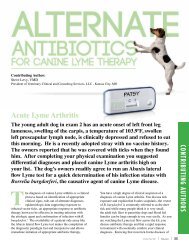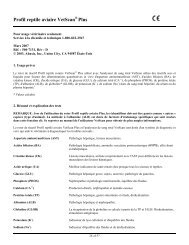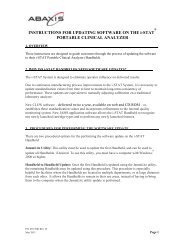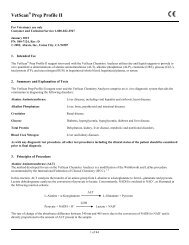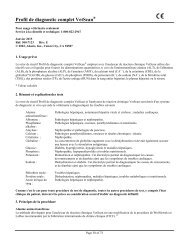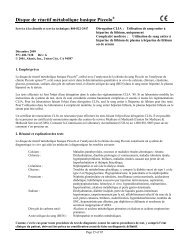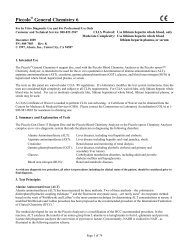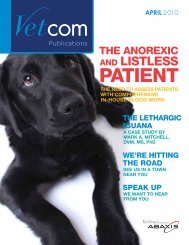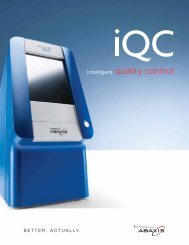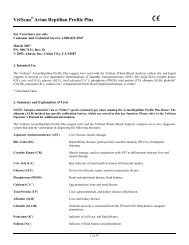Avian Blood Collection Techniques - Abaxis
Avian Blood Collection Techniques - Abaxis
Avian Blood Collection Techniques - Abaxis
You also want an ePaper? Increase the reach of your titles
YUMPU automatically turns print PDFs into web optimized ePapers that Google loves.
<strong>Avian</strong> <strong>Blood</strong> <strong>Collection</strong> <strong>Techniques</strong><br />
Reviewed & Edited by Don Harris, DVM<br />
1. Calculate the maximum blood volume you may collect from the avian patient.<br />
General rule of thumb indicates this to be no more than 1% of total body weight (or<br />
approximately 10% of blood volume in a normal bird).<br />
2. Select the appropriate blood collection tools.<br />
A 22-27gauge needle is appropriate for most avian patients. Although the smaller needle<br />
size (e.g. 27-gauge) may be used to reduce trauma, it also increases the risk of hemolysis.<br />
The syringe used should not be rinsed with anti-coagulant, as this will introduce dilution<br />
errors in the sample.<br />
A micro- blood collection tube with anticoagulant should be used to preserve the<br />
collected sample. Lithium Heparin (green top) is the anticoagulant of choice for<br />
chemistry analysis. Potassium EDTA (purple top) is the anticoagulant of choice for<br />
hematological analysis. In reality however, the Lithium Heparin tube is satisfactory for<br />
both chemistry and hematology. K-EDTA tubes however should never be used for<br />
chemistry analysis (results in falsely elevated potassium/falsely depressed calcium). A<br />
microscope slide/s should be available for immediate preparation of a blood smear.<br />
3. Select site for phlebotomy.<br />
Jugular: the right jugular is the largest and by far the most preferred site for avian blood<br />
collection. It is easily visualized by applying a small amount of alcohol to the featherless<br />
tract on the right side of the neck. The vein should be occluded with a thumb or<br />
forefinger at the level of the thoracic inlet prior to venipuncture.<br />
Basilic: this wing vein is located over the medial surface of the proximal ulna, and may<br />
be convenient in some species. It is however, much more prone to hematoma requiring<br />
application of pressure upon removal of the needle. I recommend avoiding it.<br />
Metatarsal: this vein is located above the tarsometatarsal joint (hock) on the median<br />
side of the leg and may be preferred for pigeons, chickens and ducks.<br />
Toenail Clip: this is the least preferred method of blood collection due to the probability<br />
of introducing artifacts into the sample. When used, the toenail must be thoroughly<br />
cleaned with alcohol and dried prior to collection. A very sharp and properly functioning<br />
clipper should be used with the free-flowing blood collected into the appropriate tube.<br />
Ferric subsulfate or silver nitrate may be used for post-sample hemostasis.<br />
4. Prepare the patient for phlebotomy.<br />
Restrain the bird, optimally utilizing a clean towel. Avoid restricting patient breathing<br />
and overheating.<br />
Fractious patient and/or inexperienced clinicians may indicate isoflurane sedation of the<br />
avian patient prior to blood collection.<br />
5. Collect no more than 1% of body weight in blood volume of healthy avian patientsless<br />
with illness.<br />
Prepare collection site by cleaning with alcohol. If collecting from the jugular, be sure to<br />
occlude the vein with a thumb or forefinger at the level of the thoracic inlet prior to<br />
venipuncture.<br />
Needle may be inserted bevel-up or bevel-down, depending on operator comfort. I find<br />
the bevel down insertion method highly preferable as it allows for gentle tenting of the<br />
vein and rapid collection.<br />
The syringe should not contain an anticoagulant due to resultant deleterious dilution<br />
effects of the sample.
6. Transfer blood from the syringe appropriately.<br />
Remove the needle from the syringe prior to transfer to avoid hemolysis resulting from<br />
forced expulsion back through the needle. If a tuberculin syringe with a permanent<br />
needle is used, a Rescoe nail trimmer can be used to cut off the needle end of the syringe<br />
before the blood is transferred to transport containers.<br />
Ideally, prepare 2 blood smears directly from the syringe, immediately after blood<br />
collection. These slides can be used for leukocyte differential and morphological<br />
examination as well as manual cell counts. If collection was delayed for any reason,<br />
immediately transfer the blood into the appropriate tube.<br />
Transfer blood to a Lithium Heparin microtainer tube (green top). The tube should be<br />
filled a minimum of half-full to avoid significant dilution effects. This tube may be used<br />
for chemistry analysis as whole blood or plasma.<br />
NOTE: Li-Hep anticoagulated samples will yield more plasma from the same volume of<br />
whole blood than if the sample was allowed to clot and serum is separated.<br />
Additional blood may be transferred to a Potassium EDTA microtainer tube for<br />
hematological analysis. This purple-top tube should not be used for chemistry analysis as<br />
the anticoagulant will falsely elevate potassium and falsely depress calcium values.<br />
Sample Quality Issues & Effects<br />
Hemolysis:<br />
Most hemolysis can be avoided with good collection technique and removal of the needle<br />
from the syringe prior to transferring blood into collection tubes.<br />
Hemolysis can effect a number of test values including:<br />
Potassium<br />
Phosphorus<br />
Bile Acids<br />
CK<br />
ALP<br />
(falsely elevated)<br />
(falsely elevated)<br />
(falsely elevated)<br />
(falsely elevated)<br />
(falsely elevated)<br />
Lipemia:<br />
Postprandial lipemia is relatively rare in the avian patient, and as such is more often<br />
associated with the female reproductive cycle, anorexia, or a hepatic disorder.<br />
Lipemia can affect a number of test values including:<br />
Bile Acids<br />
Calcium<br />
Phosphorus<br />
Uric Acid<br />
Total solids<br />
(falsely elevated)<br />
(falsely elevated)<br />
(falsely elevated)<br />
(falsely elevated)<br />
(falsely elevated)<br />
Artifacts- Contamination:<br />
Artifacts such as tissue, debris and bacteria can be minimized, or eliminated altogether<br />
with proper technique. Toenail clip is the least desirable method of blood collection due<br />
to the high probability of introducing artifacts into the sample.



